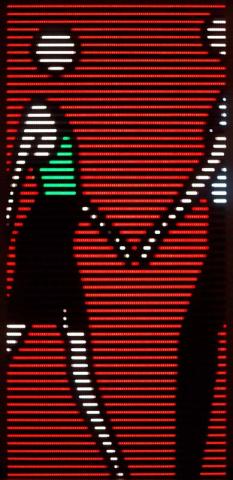OPIE, Julian; People walking. Coloured
Since his first exhibitions in the early 1980s, Julian Opie has forged a unique art practice that draws on diverse influences such as classical portraiture and sculpture, Japanese woodblock prints and the graphic properties of signage. At its heart, his work is concerned with the idea of representation and the manner in which we make sense of pictures by connecting them to things, people or places.
Opie is renowned for his highly simplified visual language employed across a broad range of art forms including printmaking, sculpture, painting, installation and animation. He has also been active in the broader cultural sphere — especially via his collaborations with UK musicians Blur, St Etienne and U2 on album art work and stage sets.
The fascinating paradox of Opie’s works is that while he employs a high degree of abstraction and abbreviation to produce a figurative image, the works often retain a strong connection to actual subjects. In discussing his working process, Opie says ‘my work isn’t about paring things down but about starting from something simple and building the image up until I achieve a kind of singularity’.(1) In other words, Opie is interested in the point at which the ‘universal’ becomes ‘particular’. As a result of this approach, his works express archetypes, while they also describe uniqueness and specificity. Far from the anonymous pictograms normally viewed in the public sphere, Opie’s portraits, for example, are strangely full of individuality and personality.
People walking. Coloured 2008 belongs to an ongoing series of large-scale LED (light-emitting-diode) works depicting walking figures in a manner that evokes the ubiquitous green man of pedestrian crossings. The technology used to display the work is similar to the large LED screens used for stadium television displays and it is able to be displayed indoors and out. Opie has often employed commercial and industrial media in his art works and his use of LEDs is perhaps motivated by the increasing prevalence of this technology in the public sphere — for applications from traffic lights through to public signage.
Each figure in the work is depicted with an extremely restrained and limited amount of pictorial information; each is literally faceless and dressed in generic outfits suggestive of an affluent, contemporary Western city. Curiously, however, Opie has given very careful consideration to each figure's gait and posture, giving them a highly individual and strangely life-like quality.
The flow of people across the screen has no discernible beginning or end, creating an hypnotic, mesmeric rhythm suggestive of the endless flow of people in contemporary cities. While the work is obviously presenting an artificial version of reality it nonetheless feels very closely connected to actual human subjects. As writer Sandy Nairne has posed in relation to Opie’s work: ‘What is the absolute minimum by which a person can be represented? What are the intrinsic elements that convey a person’s specialness? How can a mix of colours and line convey someone’s character or personality?’(2) Ultimately, it is a work that leaves us asking questions about the relationship between a picture of reality and reality itself.
Nicholas Chambers, Artlines 3-2009, pp.34–35.
Endnotes
1 Greg Hilty, Julian Opie [exhibition catalogue], Lisson Gallery, London, 2008, unpaginated.
2 Sandy Nairne, ‘Essential portraits’, in Julian Opie, Hatje Cantz, Ostfildern, 2008, p.11.
